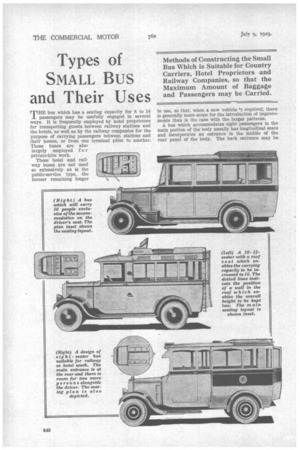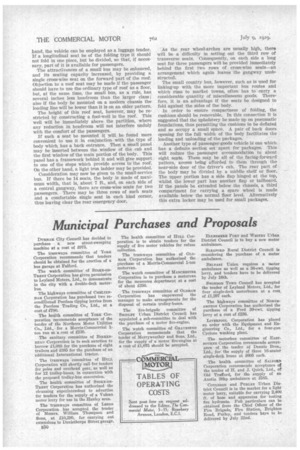Types of SMALL BUS and Their Uses
Page 106

Page 107

Page 108

If you've noticed an error in this article please click here to report it so we can fix it.
Methods of Constructing the Small Bus Which is Suitable for Country Carriers, Hotel Proprietors and Railway Companies, so that the Maximum Amount of Baggage and Passengers may be Carried.
THE bus which has a seating capacity for 8 to 14 passengers may be usefully engaged in several ways. It is frequently employed by hotel proprietors for transporting guests between railway stations and the hotels, as well as by the railway companies for the purpose of carrying passengers between stations and their homes, or from one terminal pOint to another. These buses are also
largely employed f o r private-hire work.
These hotel and railway buses are not used so extensively as is the public-service type, the former remaining longer in use, so that, when a new vehicle ;I required, there is generally more scope for the introduction of improvements than is the case with the larger patterns.
A bus which accommodates eight passengers in the main portion of the body usually has longitudinal seats and incorporates an entrance in the middle of the rear panel of the body. The back entrance may be considered old-fashioned, but the body is too short to permit a side entrance to be usefully employed, if there is to be a partition behind the driver's seat and if the seating siiace is to be turned to the best advantage. The bodywork, however, may be brought into line with present-day design by enclosing the driver's compartment and extending the panels below the top line of the chassis.
If the bus should have, say, 10 seats, not including room for one or two passengers beside the driver, provided that the wheelbase be suili,ciently long, the more attractive side entrance and cross-wise seats may be adopted. Space for the disposal
of the seats, however, will be limited and it will seldom be possible to arrange all of them so that they face in a forward direction.
A suitable seating plan for a vehicle designed to carry 10 passengers consists of a forward scat situated in the main part of the body, with the back against the partition, to hold three persons. Behind this there should be a pair of facing-forward seats, that on the near side accommodating two, whilst the off-side seat
should be designed to carry one passenger. Then, at the back, a full-width seat for four passengers would complete the scheme. By placing the first seat, which faces the rear, against the off side, space is left at the doorway, thus facilitating entry and exit.
An hotel or private-hire bus which embodies the seating plan outlined above will have, in addition, a door on each side of the driver's compartment. Drop or sliding windows should be provided in the partition, whilst all the main windows should be capable of being raised a n d lowered.
Another variation of the nominal 10-seater has a rear entrance with a transverse seat extending the full width of the body. This seat faces the rear and holds four persons. The full complement of passengers is made up by two longitudinal seats on each side of the body, w hi c h accommodate three persons.
The advantage of the longitudinal seat over the cross-wise pattern is that, when the former is placed at a reasonable height from the floor, the space under it may be used more readily as a locker for stowing the smaller bags and parcels which cannot he carried on the roof.
The long seats may be designed so that there is space under them for luggage, and, if they be collapsible, they provide even more room for baggage. A small bus can then be used for conveying a few passengers with an extra amount of luggage, or, on the other hand, the vehicle can be employed as a luggage tender. If a longitudinal seat be of the folding type it should not fold in one piece, but be divided, so that, if necessary, part of it is available for passengers.
The attractiveness of a small bus may be enhanced, and its seating capacity increased, by providing a single cross-wise seat on the forward part of the roof. Objection to a roof seat may be made if the passenger should have to use the ordinary type of roof as a floor, but, at the same time, the small bus, as a rule, has several inches less headroom than the larger class; also if the body be mounted on a modern chassis the loading line will be lower than it is on an older pattern.
The height of this roof seat, however, may be restricted by constructing a foot-well in the roof. This well will be immediately above the partition, where any reduction in headroom will not interfere unduly with the comfort of the passengers.
If such a seat be mounted it will be found more convenient to use it in conjunction with the type of body which has a back entrance. Then a small panel may be inserted between the window of the cab and the first window of the main portion of the body. This panel has a framework behind it and will give support to one of the steps which provide access to the roof. On the other hand, a light iron ladder may be provided.
Consideration may now be given to the small-service bus. If there be 14 seats, the body is made of maximum width, that is, about 7 ft., and, on each side of a central gangway, there are cross-wise seats for two passengers. There may be three rows of such seats and a comfortable single seat in each hind corner, thus leaving clear the rear emergency door..
' As the rear wheel-arches are usually high, there will be a difficulty in setting out the third row of transverse seats. Consequently, on each side a long seat for three passengers will be provided immediately behind the first two rows of cross-wise seats—an arrangement which again leaves the gangway unobstructed.
The small country bus, however, such as is used for linking-up with the more important bus routes and which runs to market towns, often has to • carry a considerable quantity of miscellaneous goods. Therefore, it is an advantage if the seats be designed to fold against the sides of the body.
In order to ensure compactness of folding, the cushions should be removable. In this connection it is suggested that the upholstery be made up on pneumatic foundations, thus permitting the cushions to be deflated and so occupy a small space. A pair of back doors opening for the full width of the body facilitates the loading and unloading of the packages.
Another type of passenger-goods vehicle is one which has a definite section set apart for packages. This will reduce the passenger accommodation to about eight seats. These may be all of the facing-forward pattern, access being afforded to them through the near-side door of the driver's cab. The rear part of the body may be divided by a middle shelf or floor. The upper portion has a side flap hinged at the top, whilst the lower part has another flap or tailboard. If the panels be extended below the chassis, a third compartment for carrying a spare wheel is made available below the normal floor level. Alternatively this extra locker may be used for small packages.
















































































































































































